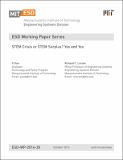STEM Crisis or STEM Surplus? Yes and Yes
Author(s)
Xue, Yi; Larson, Richard Charles
Downloadesd-wp-2014-30.pdf (594.2Kb)
Metadata
Show full item recordAbstract
Over the last decade, there has been significant concern regarding a shortage of science, technology, engineering, and mathematics (STEM) workers to meet the demands of the labor market. At the same time, many experts have presented evidence of a STEM worker surplus. The literature tends to lean heavily in one direction or the other: one side proclaims an impending STEM crisis and the other side asserts a STEM surplus. This paper tries to reconcile the “STEM Crisis” vs. “STEM Surplus” debate by segmenting the STEM labor market into different industries, occupations, and skill levels. We conduct an in-depth analysis of the STEM labor market using a comprehensive literature review in conjunction with sources such as employment statistics, newspaper articles, and authors’ interviews with company recruiters. Our findings indicate a significant heterogeneity in the STEM labor market. While the academic sector is generally oversupplied, the government and government-related sector has shortages in specific areas such as nuclear engineering, materials science, and electrical engineering, as well as cybersecurity and intelligence. The private sector also has specific shortages for positions such as petroleum engineers, data scientists, and software developers. At the same time, there are surpluses for graduates in areas such as chemistry and physics. The demand and supply also vary according to location and U.S. citizenship. Based on our analysis, we discuss policies to address the STEM workforce demand and supply.
Date issued
2014-10Publisher
Massachusetts Institute of Technology. Engineering Systems Division
Series/Report no.
ESD Working Papers;ESD-WP-2014-30